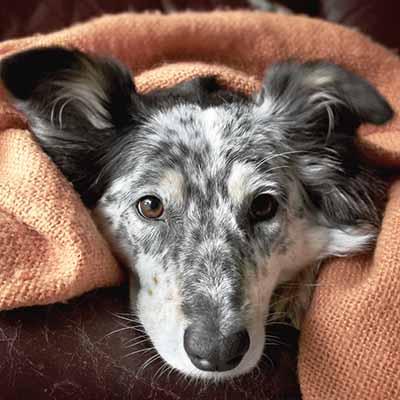Home » Blog » Could your dog have the flu?
Is Your Pooch as "Sick as a Dog?" It Could Be Dog Flu
Your dog can indeed get the flu, although it’s not from the same strains humans get. Canine influenza is a respiratory illness caused by two distinct types of influenza virus, H3N2 and H3N8, which affect dogs and other animals. Here’s how to tell if your pooch has the flu and what to do about it.

Dog Flu Symptoms
Dogs catch all kinds of respiratory bugs, from the sniffles and colds to pneumonia and the flu. Socially active dogs are particularly susceptible to the canine flu because the virus is airborne and spreads through close contact. But, just as with humans, telling one illness from another isn’t always easy.
Some dogs show no signs of illness, but a dog with the flu (canine influenza) may have these symptoms:
- Frequent coughing, which may sound like hacking or choking
- A runny nose that is more productive than a healthy, cold, wet nose
- Thick or runny eye discharge that looks like mucus
- A loss of appetite, although some dogs will eat under any circumstances
- Physical weakness, low energy, or disinterest in play
- Body temperature of 102.5 degrees Fahrenheit or higher
To detect fever in a dog you don’t need a thermometer. A dry, hot nose is a clear sign. Feeling your dog’s ears, paws, and leg joints (armpits) with the back of your hand will also reveal higher-than-normal temperatures. While red, dry gums may indicate fever, consider this a back-up sign as it can also indicate gum disease.
Influenza "Gone to the Dogs."
Dog flu is highly contagious and spreads through the air when your dog coughs or sneezes. The virus also lives in an infected dog’s saliva and spreads through surface contact, shared water bowls, nipping, licking, or nuzzling nose-to-nose.
According to the US Centers for Disease Control, the canine influenza virus can’t infect you or your human family members. That’s a relief for you, but your cat has one more reason to dislike the family dog: one strain of the canine flu virus has been shown to infect cats. Because the illness can take between two weeks and four weeks to resolve, it’s best to keep your sick dog away from other pets whether at home or in public.

Dog Flu Prevention
If your dog has been hanging out with a pack of sickies at the kennel or dog park, and even if he hasn’t, wash his paws after contact for safe measure. Or give him a good scrub-up . And to protect your dog from the contagion for an entire flu season, consider the canine influenza vaccine available from your vet. Even if you skip the flu shot, keeping a close watch your dog and others for signs of the flu – and acting quickly when you see the signs – will go a long way toward keeping your beloved pooch healthy and flu-free.
Source: Centers for Disease Control and Prevention. “Canine Influenza.” CDC.gov. Centers for Disease Control and Prevention (accessed 20 September 2018).